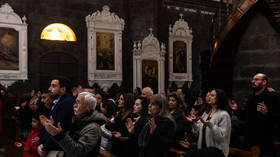Pskov: struggle to preserve cultural traditions
Around six hundred kilometers from Moscow, Russia's Pskov region has traditionally been a land of striking natural beauty and ancient monuments. It is also home to an officially protected ethnic minority: the Setos.
Their culture blossomed in the early twentieth century, but now the number of Setos is dwindling.
The entire ethnic group is settled in only one place in Russia. The annual festival is meant to be a celebration of their land, but each year there are fewer of them to celebrate it. No more than 200 Setos remain in Russia.
“We cling on to these rituals to preserve whatever culture we have left,” Helyu Mayak, a Seto ethnographer explains.
Tatyana Ogareva, a local museum keeper, showed RT around what she called a memorial. A century ago there were 20,000 Seto people.
Then the Russian Empire collapsed, replaced by the Soviet Union. The Setos were rugged individual, rather than collective, farmers, and did not integrate easily.
“Some Seto people were deported,” Tatyana says.
“Others were stripped of their holdings, and forced into collective farms. Those who were left went west to Estonia.”
Although ethnically similar to Estonians and Orthodox Christians like Russians, Setos have their own culture and language.
They have been listed as a protected ethnic minority in the Pskov Region. The majority of them, however, live across the border – in Estonia.
Russian Seto people are taught nowadays about the traditions that were originally followed in the so-called Seto Land.
These people are famous for their distinctive handicrafts, clothes and songs.
The museum in Pskov faithfully recreates all the aspects of the Seto lifestyle, but if things remain the way they are, soon this will be the only reminder they were ever here in the first place.
Where there was once oppression, now there are economic reasons for the Seto decline. The traditional isolated Seto landholdings have grown unsustainable.
Estonia, the wealthier neighboring EU state is where most Seto people now live. Anni is one of the few who's stayed true to her roots.
“Life is hard here. Over the border there is a normal life with all the modern amenities, while here there is none of that,” she confesses.
With state funding, festivals and museums in both Russia and Estonia, the traditions of the Seto people are finally being recognized and celebrated.
But the crunch of history and the attraction of urban lifestyles mean that it may be too late to save even what little there is left.
A common effort
Russia and Estonia have launched several bilateral programs to help preserve the Seto lifestyle and cultural heritage.
Some local Pskov projects have also been organized to promote the Seto culture. For example, as Denis Kugay, manager of the Euro faculty Pskov project told RT, a Seto festival will be conducted locally in August.
“There is also a society for cultural and ethnic studies on [the] Seto [culture], and there is a museum,” Denis Kugay said.
“So there are enthusiasts,” he added.
A distinguished history
Although the Seto population in the Pskov region may be dwindling, their history is recognized as a long and rich one.
The Seto group is said to be a splinter from the Finnish population, explains Svetlana Chastchenko, a department head of the Pskov Museum.
Finnish tribes settled in the Pskov region in the beginning of the Common Era. When Russian Slavic tribes took hold of the region in the 6th Century A.D, both the Finnish and Seto tribes were assimilated into the state of Rus.
“Now, the Setos are living along the border between Russia and Estonia,” Svetlana Chastchenko notes.
A school of three cultures
A special school in the Pskov region focuses on teaching its 130 pupils the three cultures which they are surrounded by: Russian, Estonian and Seto.
Svetlana Konkova, a teacher at the school, thinks the children are keen to learn the Seto language.
“It’s not only about the lesson,” she says.
“We have [folk music and dance] ensembles. The kids go on expeditions to villages where Seto people live.”
Business ties
Local businessmen also think that it is very important to maintain strong ties with the Seto population. Indeed, it is very much related to the Pskov region’s history.
As long as a century ago, Pskov’s merchants were part of a trade union which collaborated closely with the Setos.
Vladimir Zubov, head of the Pskov chamber of commerce, insists that this traditional link is still kept alive.
“Of course we protect historical traditions,” he told RT.
“We have very good social responsibility towards historical moments and especially with the society,” Zubov continued.












